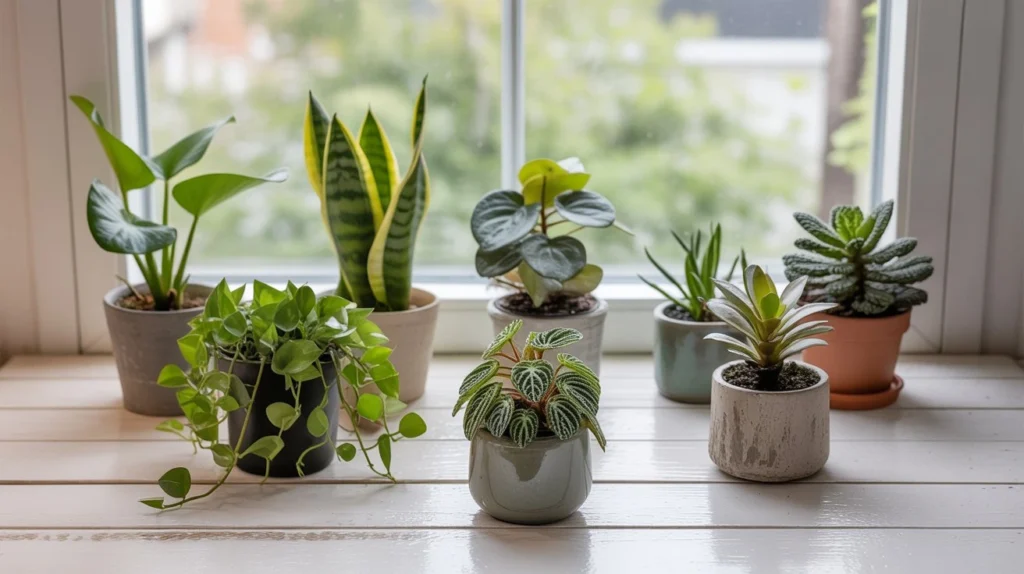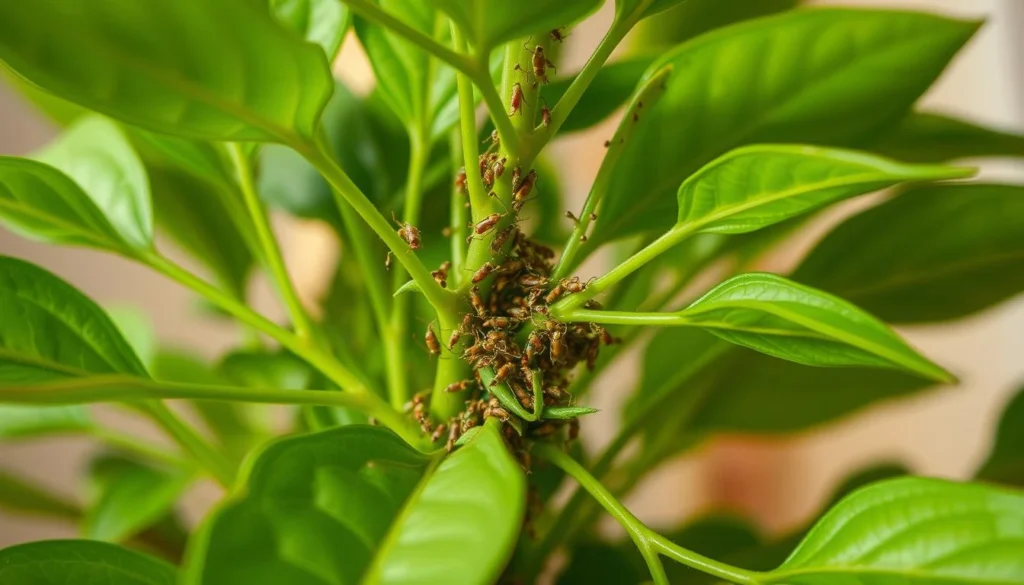
You take pride in your indoor plants, nurturing them with care. But sometimes, unwanted visitors like aphids on indoor plants can ruin the experience. These tiny insects may seem harmless at first but can cause significant damage over time.
A sticky substance on the leaves is often the first sign of trouble—an early warning that aphids on indoor plants might be the culprits. Without proper action, they can quickly spread and weaken your plants.
Effective insect control is key to preventing further infestation. In this article, we’ll share practical tips to identify and manage aphids on indoor plants, so you can keep your greenery healthy and thriving.
Table of Contents
Understanding Aphids and Their Impact
It’s important to know about aphids to keep your indoor plants healthy. Aphids are small insects that can harm your plants a lot.
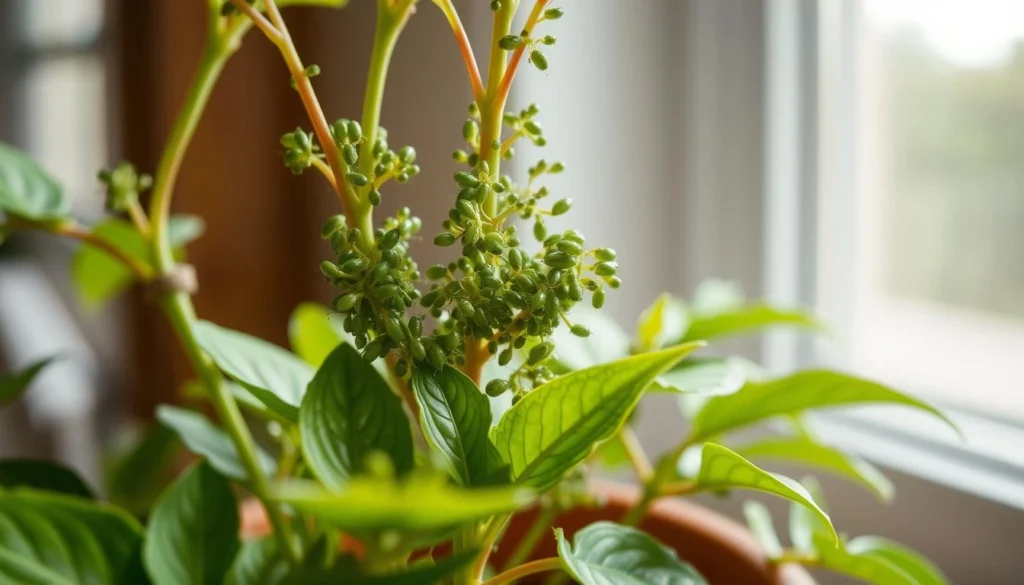
What Are Aphids and Their Life Cycle
Aphids are tiny, usually no bigger than 1/8 inch. They can be green, yellow, orange, red, beige, pink, or black. Their bodies are soft and pear-shaped, with long legs.
Aphids reproduce fast. Some can even have live young without mating. This means their numbers can grow quickly, leading to a big problem if not stopped.
Common Signs of an Aphid Infestation
Signs of aphids include curled leaves and sticky honeydew on leaves or stems. You might also see ants or other insects because of the honeydew. Look for aphids on stems or leaves, often near growing tips or on the underside.
Checking your plants often can help you spot aphids early. This makes it easier to control aphids and stop more damage.
Why Aphids Are Harmful to Your Indoor Garden
Indoor plants with aphids face direct harm and secondary issues. Aphids love young, tender growth. They can cover it completely.
Direct Damage Caused by Aphid Feeding
Aphids eat plant sap, causing leaves to curl and distort. This damage affects your plants’ looks and health. It’s important to know how much harm aphids can do.
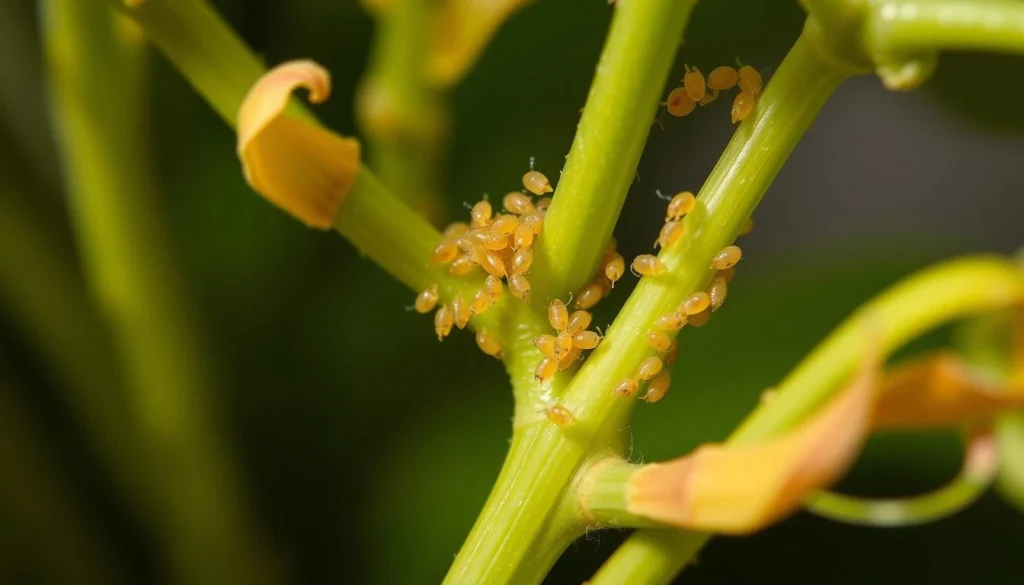
Secondary Problems: Honeydew and Sooty Mold
Aphids make a sticky substance called honeydew. This coats leaves and stems. In damp conditions, it can cause sooty mold, a black fungus. Good pest management means tackling these problems too.
| Problem | Cause | Effect |
|---|---|---|
| Direct Damage | Aphid Feeding | Curled, Distorted Leaves |
| Honeydew | Aphid Excretion | Sticky Leaves and Stems |
| Sooty Mold | Honeydew in Moist Conditions | Black Fungus Growth |
Knowing these problems helps find natural remedies for aphids on indoor plants. It keeps your garden healthy.
Identifying Different Types of Aphids on Indoor Plants
There are many types of aphids that can harm indoor plants. Knowing the differences is important for managing them well. Aphids vary in color, including green, black, and white, each with its own traits.
Green Aphids (Common Houseplant Aphids)
Green aphids are very common on indoor plants. They are small and soft, sucking plant sap. This makes leaves curl or become distorted.
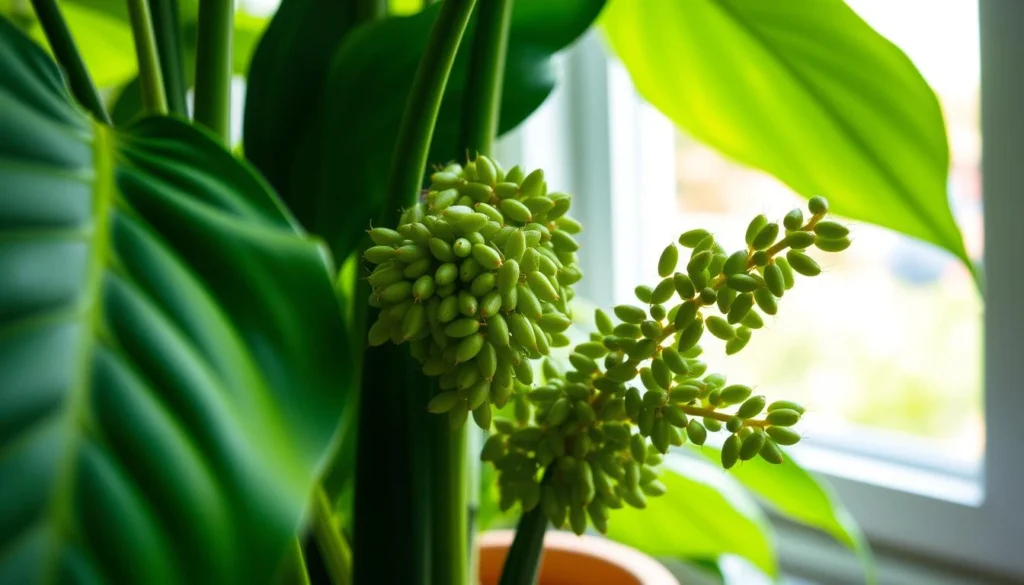
Black Aphids
Black aphids also infest indoor plants. They have a preference for certain plants and can do a lot of damage if not stopped. They secrete honeydew, which can lead to sooty mold.
Woolly Aphids
Woolly aphids look fuzzy because of a white, waxy coating. They are less common but can cause problems. They feed on plant sap, weakening the plant over time.
| Type of Aphid | Characteristics | Damage Caused |
|---|---|---|
| Green Aphids | Small, soft-bodied, green in color | Curled or distorted leaves |
| Black Aphids | Small, soft-bodied, black in color | Honeydew secretion, sooty mold |
| Woolly Aphids | Covered in white, waxy substance | Weakened plant, reduced growth |
Natural Remedies for Aphids on Indoor Plants
Natural remedies are a safe and effective way to fight aphids on indoor plants. They are gentle on plants and the environment. You can use several organic treatments to get rid of aphids and stop them from coming back.
Water Spray Method
Using a strong jet of water is a simple and effective way to control aphids. It’s great for mild infestations. Make sure to spray the undersides of leaves and stems where aphids often hide.
Soap and Water Solution
A mild dish soap mixed with water can kill aphids. Mix 1 tablespoon of soap with 1 quart of water and spray it on the affected areas. This solution suffocates the aphids.
Neem Oil Treatment
Neem oil is organic and safe for houseplants. It stops aphids from reproducing by disrupting their hormonal system. Follow the product’s instructions to mix neem oil with water and spray it on your plants.
Essential Oil Sprays
Certain essential oils, like peppermint, garlic, and chamomile, can repel aphids. Mix a few drops of the essential oil with water and spray it around your plants. Always test a small area first to make sure the oil doesn’t harm your plants.
Homemade Garlic and Pepper Sprays
A homemade spray made from garlic and pepper can deter aphids. Blend garlic and hot peppers with water, then strain the mixture and spray it on your plants. This spicy concoction will help keep aphids away.
By using these natural remedies, you can effectively control aphids on your indoor plants without harsh chemicals. Regularly check your plants and repeat the treatments as needed to keep the infestation under control.
Biological Control Methods for Aphids on Indoor Plants
Biological control is a green way to fight aphids on indoor plants. It uses natural enemies of aphids to keep them in check. This approach is both targeted and eco-friendly.
Beneficial Insects: Ladybugs and Lacewings
Ladybugs and lacewings are top choices for fighting aphids. Ladybugs eat a lot of aphids quickly. Lacewings, in all stages, also target aphids, helping to control them.
Adding these insects to your indoor garden can greatly reduce aphid numbers.
Parasitic Wasps
Parasitic wasps are another effective tool against aphids. They lay eggs inside aphids, and the larvae eat them from the inside. This method is very effective and doesn’t harm other good insects.
Using Beneficial Insects Indoors
When using beneficial insects indoors, it’s key to introduce them carefully. You might release them on infested plants or use special enclosures. Keeping an eye on your garden’s temperature and humidity helps these insects work better.
Chemical Control Options for Severe Infestations
When aphids infest your indoor plants, chemical controls can help. Natural remedies are usually the first choice. But, for severe cases, chemicals might be needed.
Chemical methods for fighting aphids include various products. They are useful when infestations spread or other methods don’t work.
Insecticidal Soaps
Insecticidal soaps are a gentle chemical option. They break down the aphid’s exoskeleton and dehydrate them. These soaps are mostly safe for plants but test them first.
Horticultural Oils
Horticultural oils, like neem oil, are effective against aphids. They suffocate the aphids and control other pests too. Mix these oils with water and spray them on the plants.
Systemic Insecticides
Systemic insecticides are absorbed by the plant. They target aphids that feed on the sap. These are for severe cases and can be more dangerous, so use them carefully.
| Chemical Control Method | How it Works | Precautions |
|---|---|---|
| Insecticidal Soaps | Dehydrates aphids by breaking down their exoskeleton | Test on a small area first to ensure plant safety |
| Horticultural Oils | Suffocates aphids | Mix with water according to instructions; can be toxic to beneficial insects |
| Systemic Insecticides | Absorbed by the plant, toxic to aphids that feed on sap | Use with caution; can be toxic to humans and pets if ingested |
Step-by-Step Guide to Treating Aphid-Infested Plants
Aphid infestations can be tough to handle, but a good plan can help. To treat aphid-infested plants, follow a few important steps. These steps can get rid of the aphids and stop them from coming back.
Isolating Affected Plants
It’s key to keep affected plants away from others. Move the infested plant to a separate spot. This stops aphids from spreading to other plants.
Removing Visible Aphids
Next, get rid of the aphids you can see. Use water or a soft brush to remove them from leaves and stems. This step helps lower the aphid count and makes treatments work better.
Applying Your Chosen Treatment
After removing aphids, use your chosen treatment. This could be neem oil, insecticidal soap, or introducing beneficial insects. Always follow the product’s instructions for how much to use and when.
Follow-up Care and Monitoring
After treatment, keep an eye on your plants. Look for aphids and repeat treatments if needed. This ensures the treatment works and keeps aphids away.
Read More :
Indoor Ivy Plants: Tips for Thriving Greenery
Conclusion
Keeping your indoor garden healthy is more than just watering and feeding your plants. It’s also about stopping aphids from harming them. Knowing how aphids live and what they do can help you protect your plants.
Checking your plants often and keeping things clean is important. Also, isolating new plants and using neem oil can stop aphids. These steps can greatly lower the chance of aphids ruining your plants.
Managing pests in your indoor garden is a constant job. Always be on the lookout and use the right methods. This way, you can have a beautiful, healthy indoor garden without aphids.
FAQ
What are aphids and how do they harm my indoor plants?
Aphids are small, soft insects that feed on plant sap. They cause leaves to curl or grow distorted. They also lead to stunted growth and a sticky substance called honeydew. This substance attracts pests and promotes sooty mold.
How can I identify an aphid infestation on my indoor plants?
Look for aphids on your plants and signs like curled leaves. Also, check for sticky honeydew and ants, which are drawn to it.
What are some natural remedies for controlling aphids on indoor plants?
Try a water spray to remove aphids. Use a soap and water solution to kill them. Neem oil, essential oils like peppermint, and garlic pepper sprays can also repel and kill aphids.
How can I use beneficial insects to control aphids on my indoor plants?
Introduce ladybugs, lacewings, or parasitic wasps to your plants. These insects eat aphids. Make sure to research their needs before introducing them indoors.
What are some chemical control options for severe aphid infestations?
For severe cases, use insecticidal soaps, horticultural oils, or systemic insecticides. Always follow instructions and take precautions to avoid harm.
How do I treat aphid-infested plants effectively?
Isolate the affected plants and remove visible aphids. Apply your chosen treatment and monitor regularly. Repeat treatments as needed.
How can I prevent aphid infestations on my indoor plants?
Regularly inspect your plants and keep them healthy and watered. Avoid over-fertilizing and isolate new plants before introducing them to your garden.
Are there different types of aphids that can infest my indoor plants?
Yes, there are several types, including green, black, and woolly aphids. Each type has its own characteristics and effects on plants.
Can I use a combination of methods to control aphids on my indoor plants?
Yes, combining natural remedies, biological control, and chemical options can effectively manage aphids. This approach helps prevent future problems.
